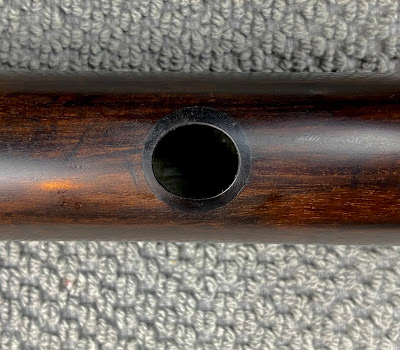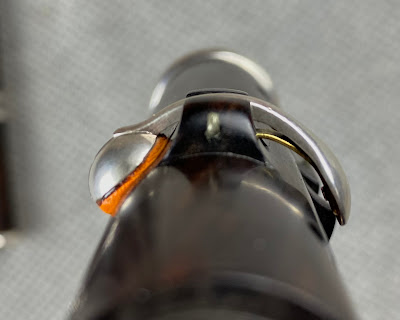This has to be one of the more interesting flutes I've restored, both in its own essence and structure, and how it came to me.
Firstly, though, let's look at what we know about the maker, William Rönnberg.
The NLI gives the usual basic information. Here's a screenshot, a bit bendy, but faster than copying it all out:-
In fact Rönnberg was one of the best documented of makers, and that through his own words. More of that later, but for the moment onto the flute.
A few years ago, I was given the task of clearing out the workshop of a long retired woodwind maker, and selling what was saleable. Among the 'debris' was a bag of old pieces of flutes, which on first glance appeared to be the sort of thing that all makers have - pieces which are kept in the hopes that they'll be useful someday. They rarely if ever are.
This bag, as is the fate of most such things, ended up in a box, under a bench in my workshop, where it kept company with several other similar bags, and probably a dozen one keyed Bb band flutes, in similar states of disrepair, and which were not even accorded the dignity of being in a bag.
Sometime later...at least a couple of years, if memory serves ( and to be honest, it often doesn't), I had occasion to root in this cornucopia, and again opened the bag, and glanced in. What caught my eye initially was a fully keyed foot. Despite being incredibly dirty, there was something about it that spoke to me, something unusual in the proportions of the keys and blocks.
So on this occasion, I looked at it a bit more closely, which confirmed that it really was quite unlike the English and continental simple system flutes with which I was familiar. I began to look a bit more closely into the bag, and eventually found what could potentially be the other two joints of the body. After consideration though, I decided that the lower middle was from a different flute, but had probably been pressed into use at some point to try and make a playable flute. That joint was a complete wreck, cracked through from end to end, keys missing.
For a day or two, I thought no more about it, but then I began to think that someone had really wanted to keep this flute playing, and maybe there was more of it in the bag. Searching again produced what now appeared to be the correct lower middle, based largely on the style of the keys.( and the style of the dirt! ) Now I had a fairly complete flute, in reasonable condition, importantly with all the keys present. Most importantly, a little cleaning showed that the three joints I now had were stamped RÖNNBERG NEW YORK.
There's a story told about a father who had an extremely optimistic son who wanted a pony for Xmas. The father decided to test his optimism and bought him a big pile of manure which he put under the Xmas tree ( It's a story ). Father comes down on Xmas morning to find the son digging in the manure. Son turns to father and says "There's gotta be a pony here somewhere!"
So when I realised I had all of the flute body, I, too, went digging and came up with a head and barrel which had potential, but which looked wrong in certain aspects. One thing, though, finally convinced me that the head was right, and that was the type of wood.
I've spoken in some of my other posts about a type of wood that has been used for flute making a lot more extensively than is generally realised. This wood is from the Platymiscium genus of trees, and I believe it may be the original meaning of grenadilla, before that term came to be used to mean African blackwood. Rönnberg himself had something to say on this matter, which we'll look at later, but for the moment I was happy now to confirm that I now had all five pieces of the original flute.
Here's what it looked like.
One of the things that initially fooled me about the head, was that the original rings had been replaced. I also eventually came to realise that the barrel, although apparently from the same wood was not the original.
Stripping the flute down showed some interesting features. The head was cracked and required the removal of the liner in the course of the repair. This revealed a beautifully even oval in the liner, the result of a very even undercut to the embouchure.
Stripping the dirt and finish from the wood, also confirmed that it was Platymiscium, as it revealed the "chatoyance" ( cat's eye) effect in the grain which is so typical of this wood.
It also revealed the care that Rönnberg took in concealing some small defects in the wood.
Here he inset a plug to replace a knot
or small grain defect, rather than simpler fill it with shellac as was the common solution.
In close up....
And here a small chip on the shoulder also has a carefully inset piece to build it up.
Interestingly, although this little insert has the grain in the correct orientation, the plug shown above is end grain instead of the more disguiseable side grain. The flute had a heavy shellac finish which effectively made these little repairs invisible.
Bad and all as the condition of the flute was it was certainly very restorable. The head was the really the main area of concern. Pulling the liner to fix the crack is a standard procedure, and studying and measuring the embouchure, I decided that it had probably been slightly enlarged, albeit neatly enough. I bushed it with horn.
The barrel, although not the original one - as indicated by the fact that the tenon was too short for the barrel socket - I'm inclined to think was a barrel from another Rönnberg flute. The wood was the same, and perhaps what clinched it is that the the fit between the head and barrel liners was precise. Using that tube, I made another barrel from Platymiscium. The rings on head and barrel had to be made anew, matching the existing ones on the lower middle and foot.
Finally, the whole thing was refinished to match as closely as possible what little of the original finish remained.
Result?
I think it turned out well.
The neatness and attention to detail which I had first noticed on the foot further revealed itself when the flutes was restored. This picture of the foot with keys removed makes it easier to see them.
Note the acutely angled volcano type seatings, which are so smoothly finished. Also, most unusually, the sides of the C# and C cup blocks, are curved, a feature which I had incorporated latterly on my own keyed foot joints, but had never seen on an old flute. Ecclesiastes said it...there is nothing new under the sun. These curved block sides in unusual places are also present on the short F block, again something that I did myself. Maybe I was channeling old William Rönnberg!
Other nice details, include the way in which the springs hug the profile of the underside of the key.
 and on the low C#
and on the low C#
Finally, two other innovative and rather neat design features, both also on the foot.
Normally, the linkage between the low C and C# keys relies on the C touch overlapping the C#, so that when the C is pressed, the C # also closes. But on this flute, looking from above the two touches appear to be separate.
Take the keys off and turn them over, and you see what Rönnberg's solution to this was.
He simply extended the spring on the C# under the C touch ensuring that depressing the C closes both keys.
Since the keys are padded, any adjustment need to ensure they close simultaneously is achieved when burning in the pads.
Finally, something which I've never seen on any other flute.
Hard enough to see from the photo, the slots for the C# and C touches, don't run all the way through, but rather curve up to meet to shoulder, meaning that the floor of the slot curves up from the body of the flute to the top of the block.
Of course, a flute is more than an assembly of pieces of wood and silver. What does it sound like? How does it play?
Answer:-
As you might expect from a flute which was obviously made with such care, it plays very well.
Remember that although dating from at the earliest 1834 (the first date he's listed as being in New York, and the flute bears a New York stamp) the flute has very small holes for the period...at least from an English point of view. From the top down they measure... 7.1, 7.1, 6.5, 7.2, 7.4, 5.5mm
Unusually for a flute with small easily covered holes, the E hole is angled downwards, decreasing the distance between it and the F#.
The sounding length is 591mm again rather long, I would have thought for, such a flute. I will readily admit that my limited knowledge of American flutes doesn't allow me to make a proper comparison.
Suffice it to say to my admittedly sharp blow, it plays easily at 440 with a very small slide extension.
The internal tuning is also rather good. Here's a read out from the RTTA tuning app which shows that apart from the flat F# ( here played as 1234, and not in the vented fingering 1234 with either F key open which would bring it into pitch) and a slightly flat D, also standard, the tuning is excellent. In fact I've rarely seen one as good.
All in all a very interesting and unusual flute.
I referred above to the fact that Rönnberg was well documented as a maker, and this is due to an article which was published in "Baldwin's Musical Review" in 1879. (Vol 14, no 3, pp6, 7Sept. 1879)
This is a detailed interview in which Rönnberg talks about his life and work in considerable detail, and rather than quote from it to illustrate some of the points in this post, I've decided to give it in full in the next blog, along with a discussion of the various other flutes that are known from this maker.























